Networks of NW-orientated faults are very important on the SPJ Project, as well as across the Southern Province. On the SPJ project, the most important structure of that set is the NNW-striking McLaren Lake Fault. With its parallel and satellite deformations zones, it is known as the McLaren Lake Fault Zone (“MLFZ”), extending approximately 12 km southeast of Lake Wahnapitae on the SPJ Project until it gets transposed in the Grenville front. At SPJ, the MLFZ is associated with Cu-Au mineralization in quartz-carbonate veining at the historic Alwyn-Porcupine and Ashigami Occurrence. At the boundary of the Grenville Front, the MLFZ becomes transposed across a complex network of thrust faults and shears which helped form the Jovan, McLeod, and Palkovics polymetallic metal enrichments.
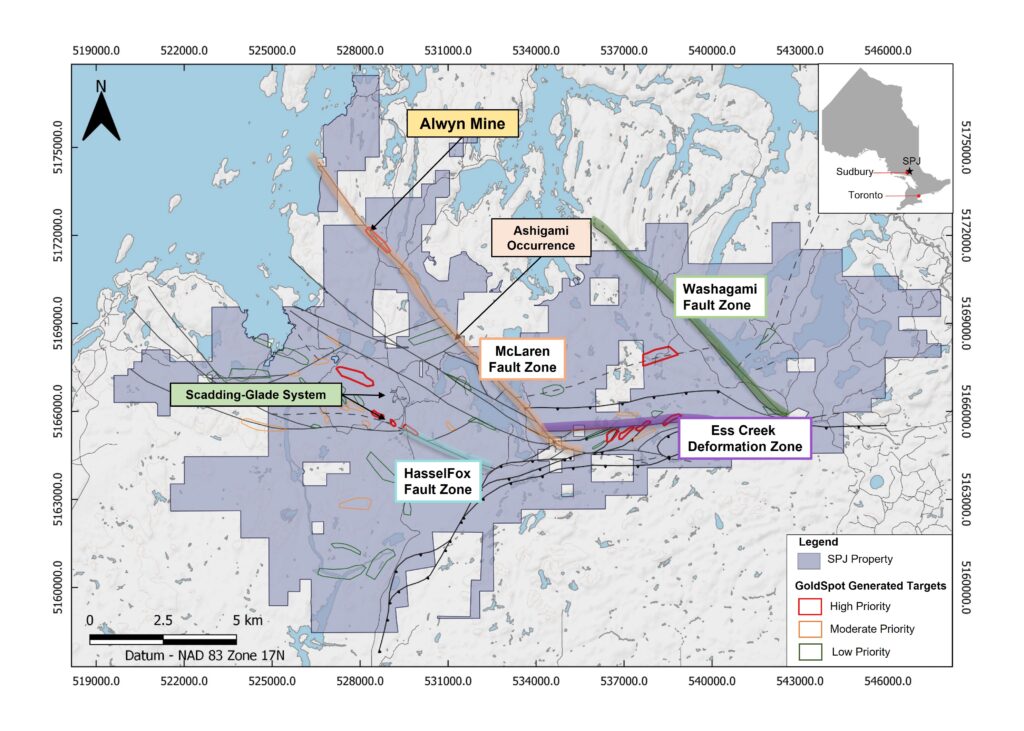
Alwyn Mine
Highlights
- Au-Cu mineralization in quartz-sulfide veins along the McLaren Lake Fault Zone (MLFZ), confirmed over a strike length of 115 m and remains open in all directions.
- Cu-Au mineralization related to incipient K-feldspar and specular hematite veins demonstrate increasing intensity with depth, indicating potential for a larger IOCG deposit model
- Widest and most significantly mineralized interval intersected during the first five hole program at Alwyn conducted in 2022 was located southeast of the Alwyn Mine beyond the historically known footprint in hole AW-22-102:
- 0.17% Cu, 0.36 g/t Au and 0.28 g/t Ag over 90.44 m in hole AW-22-102, including two zones of stronger mineralization.
- Upper zone: 41.53 m at 0.24% Cu, 0.43 g/t Au and 0.41 g/t Ag, including 1.36 % Cu, 3.87 g/t Au and 3.05 g/t Ag over 3.20 m.
- Lower zone: 13.00 m at 0.29% Cu, 0.82 g/t Au and 0.33 g/t Ag.
- Identification of cobalt anomalies in most of the drill holes completed in the Alwyn system with the broadest intersection being 0.015 % Co over 26.50 meters in AW-22-101
- Strike length of entire Alwyn mineralization trend proposed up to 2.5 km by ALS GoldSpot’s artificial intelligence generated targeting in May 2022.
- 2023 gravity survey completed over the entire Alwyn Cu-Au trend (321.9 Ha) confirmed several positive anomalies characteristic of an Iron-Oxide-Copper-Gold mineralization system spatially associated with the MLFZ , as well as intersections of structural lineaments that provide the primary plumbing for mineralizing fluids in this system.
Summary
The historic Alwyn Mine is located in the Northwestern portion of our SPJ Land Package. Past production by Alwyn Porcupine Mines Ltd. (1950-1959) included 7000 tons @ 5.67 g/t Au and 1% Cu.
The Alwyn Mine discovery featured Au-Cu-Ag mineralization in quartz-sulfide veins along the McLaren Lake Fault Zone, which is hosted by Gowganda formation sediments. Two historic drilling programs discovered significant assay results:
- 1983 – Diamond Drilling Reported intersections of up to 1.38 g/t Au over 15.4m and up to 16.59 g/t Au over 1.52 metres and 4.46 g/t Au over 3.81 metres (Cu results were not reported from this program).
- 1950 – Diamond Drilling Reported intersections of up to 3.9 g/t Au and 0.79% Cu over 6.04m
MacDonald Mines began prospecting around the Alwyn Mine in 2020 and followed up with detailed trench mapping and channel sampling of 5 previously stripped areas in 2021. Mapping demonstrated copper-gold mineralization associated with multidirectional networks of quartz-carbonate vining, hosted in Gowganda formation sediments. Mineralization consists primarily of copper and gold, with lesser silver and anomalous cobalt.
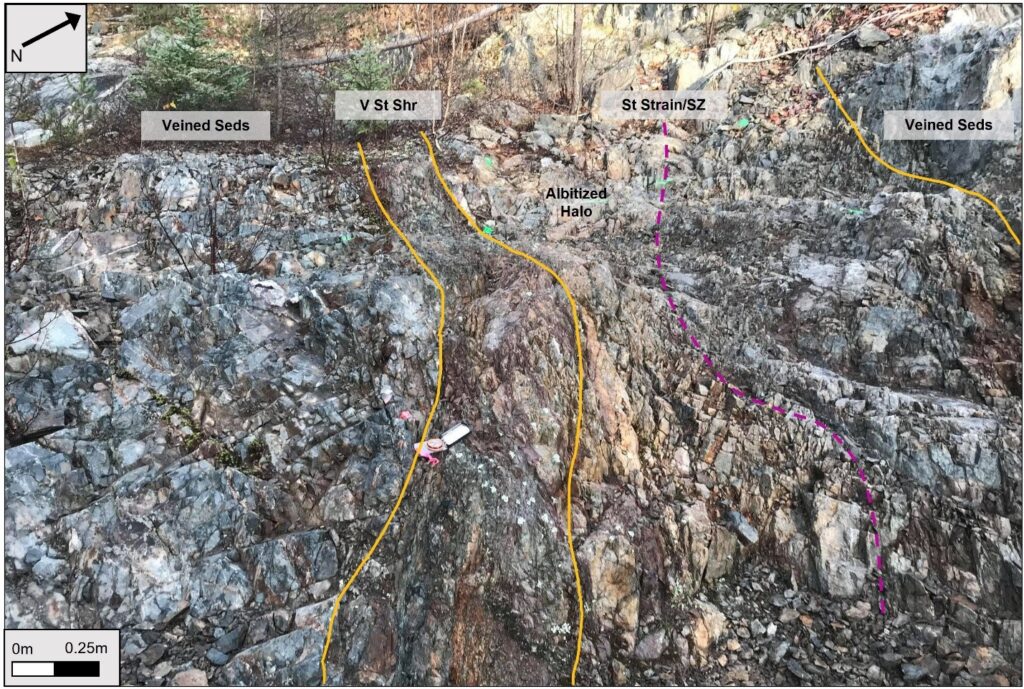
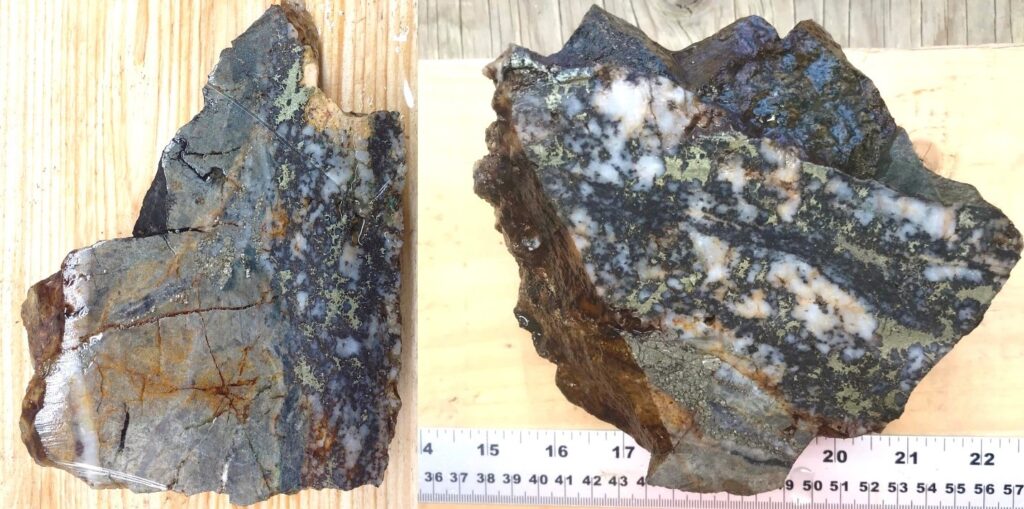
In May 2022, after ALS GoldSpot proposed an extended mineralization trend at Alwyn for up to 2.5 km southeast of the historic mine, MacDonald Mines completed five oriented drillholes targeting veining proximal to the mine. 4/5 drill holes completed in the area intercepted broad intervals (30-116m core length) of mineralization containing primarily chalcopyrite, traces of bornite and variable pyrite. Copper-gold mineralization was confirmed over a strike length of 115 m and remains open in all directions, as well as anomalous cobalt mineralization in hole AW-22-101 with 0.015 % Co, 0.017 g/t Ag, and 0.021% copper over 26.5 m. Furthermore, the strongest mineralization and alteration measured during the program occurred in hole AW-22-102, drilled in a previously untested area east of the main mine workings, and remains open at depth and to the east.
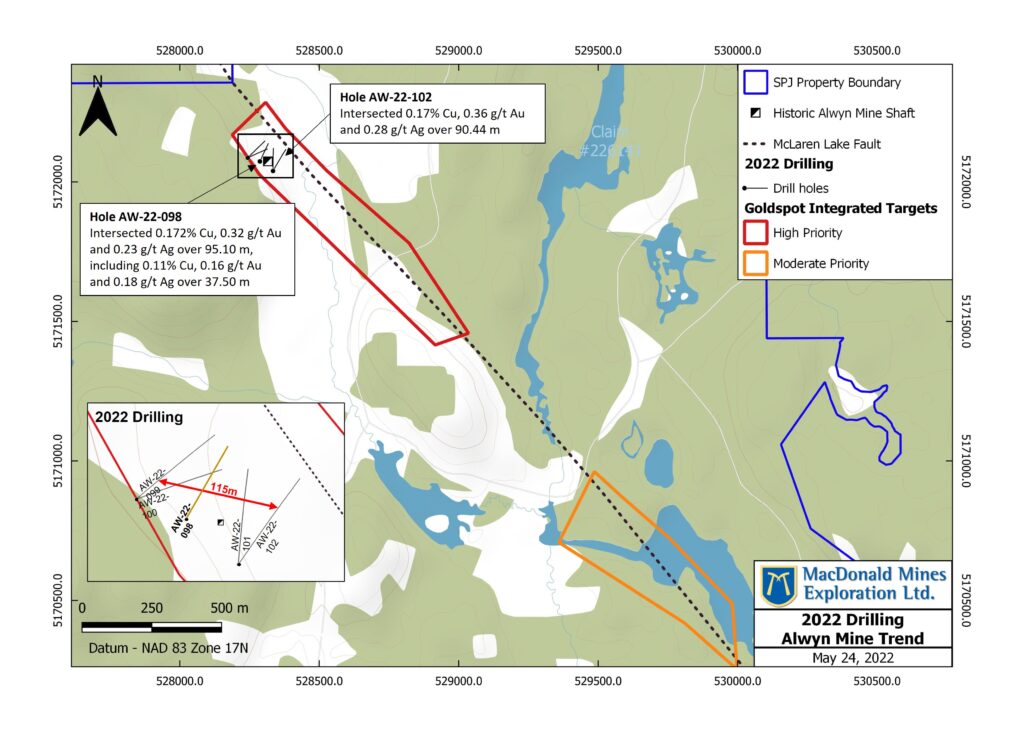
The alteration and mineralization observed throughout Alwyn demonstrates strong evidence of MIAC mineral systems. Similar to the alteration facies transitioning in the Scadding-Glade system from Fe-rich to Fe-poor (chlorite to chlorite-quartz to quartz-chlorite to quartz), Alwyn also demonstrates a transition from Fe-poor to Fe-rich alteration facies at depth. In the Alwyn system a gradual transition from Fe-poor, low temperature CO2(Ca,Fe,Mg)-Si facies (quartz-dolomite-chalcopyrite veining) to Fe-poor Si-(Fe)-K (Qtz-Kfs-Ccp +/- specular hematite), to increasingly Fe-rich, low temperature K-Fe alteration facies (Hem-sulfides-actinolite-chlorite) is occurs with increasing depth, demonstrated in the figure below. Historic geophysical surveys have only consisted of magnetic surveys in this area, which would not have been successful in identifying these zones of increased alteration and mineralization due to the lack of magnetite observed in the system thus far. Therefore, in January 2023 MacDonald Mines completed a broad gravity survey along the full length of the proposed Alwyn trend, in order to identify concentrated zones of increased iron alteration consisting of chlorite, hematite and actinolite. These new areas will be targeted in upcoming drill programs.
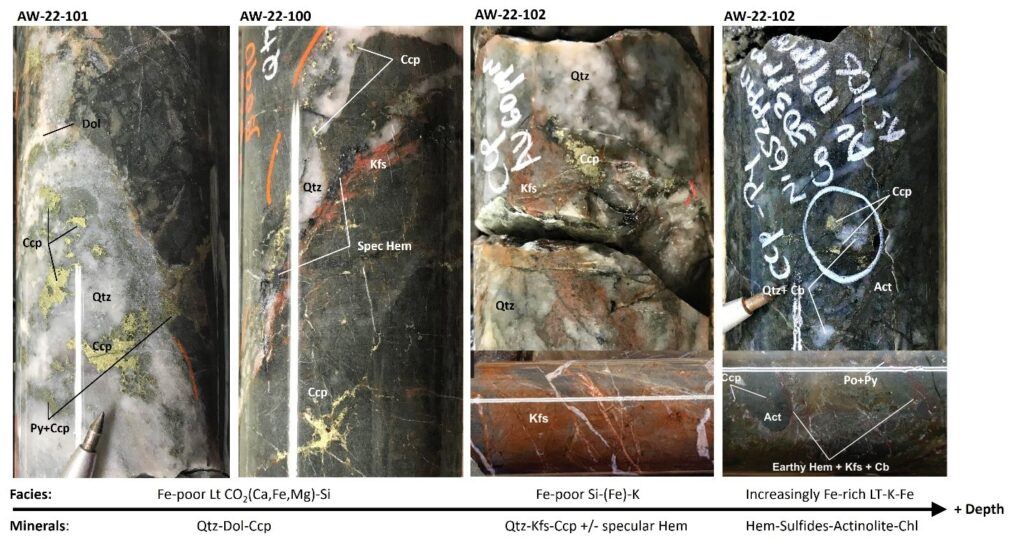
Alwyn Gravity Survey Highlights:
- ALS GoldSpot Discoveries Ltd. (“ALS GoldSpot”) has identified 5 high priority gravity targets potentially representing zones of iron-rich alteration associated along the prospective McLaren Lake Fault Zone (“MLFZ”) (see Figure 1) by integrating MacDonald Mines’ newly completed Alwyn gravity survey with regional magnetic surveys
- All anomalous gravity high zones are spatially associated to the MLFZ, as well as intersections of structural lineaments that provide the primary plumbing for mineralizing fluids in this system.
- A 250 m long, northwest trending positive gravity target was identified immediately adjacent to the 2022 Alwyn drilling
- Combined with observations of increasing iron enrichment at depth with the persistence of Cu mineralization in drilling, this anomaly supports the hypothesis for a zone of iron-rich alteration with potential to host Iron-Oxide-Copper-Gold (“IOCG”) mineralization at Alwyn.
- Magnetic lows highlighted by ALS GoldSpot’s MinusONE inversion methods outline possible regions of strong albitization associated with the MLFZ
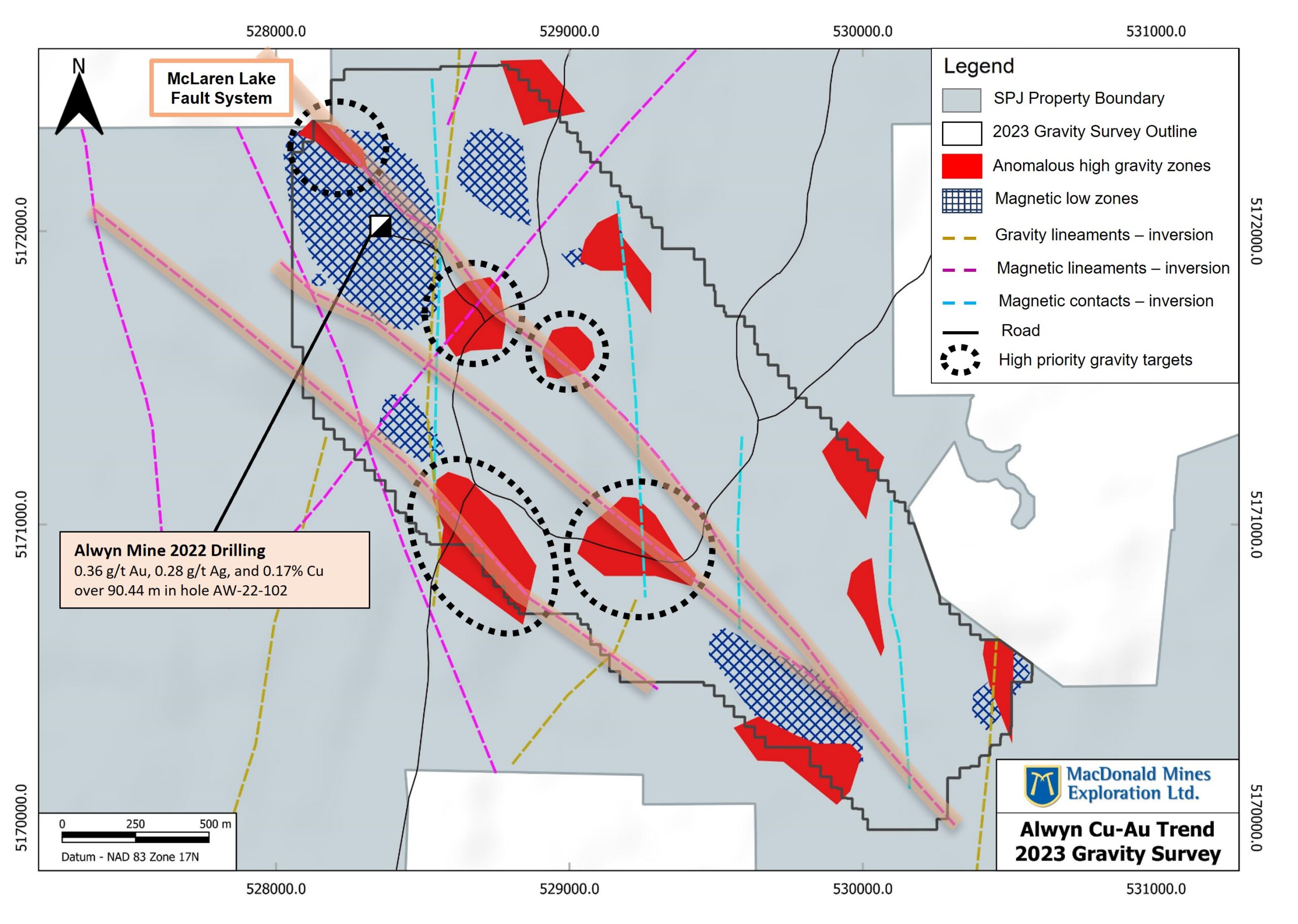
Jovan – Palkovics – McLeod Area:
Highlights
- Jovan Au-Co-Cu Showing: 6.85% Co, 7.36 g/t Au, 1.05% Cu over 0.75 m and 14.74 g/t Au, 4.70% Cu over 0.8 m in 2002 channel samples
- Palkovics: Potential for broad zones of polymetallic mineralization
- 0.15 g/t Au, 0.005 g/t Ag, and 0.01% Co over 20.48 m, including 0.17 g/t Au (JV-21-090)
- 0.035% Co over 3.15 m & 0.87 g/t Au, 0.008 g/t Ag, 0.024% Co and 0.007% Cu over 6.25 m, including 1.20 g/t Au, 0.01 g/t Ag, 0.024 % Co and 0.007% Cu over 4.25 m (JV-21-093)
- McLeod Au-Cu showing: Au grades between 0.01 and 45.5 g/t and Cu grades between 0.023% and 0.39% in grab samples collected during the 2021 field season
Summary
The Jovan area within the eastern portion of our SPJ Property is located just 500m south of the past-producing Norstar Mine, which produced 15,000 ounces of gold from 63,000 tonnes of ore grading 7.2 g/t Au and 0.9% Cu. Within the Jovan area, our team has discovered several polymetallic showings that are distributed in two corridors of mineralization and deformation: Palkovics and Ess Creek. Both Palkovics and Ess Creek feature difference centers of mineralization.
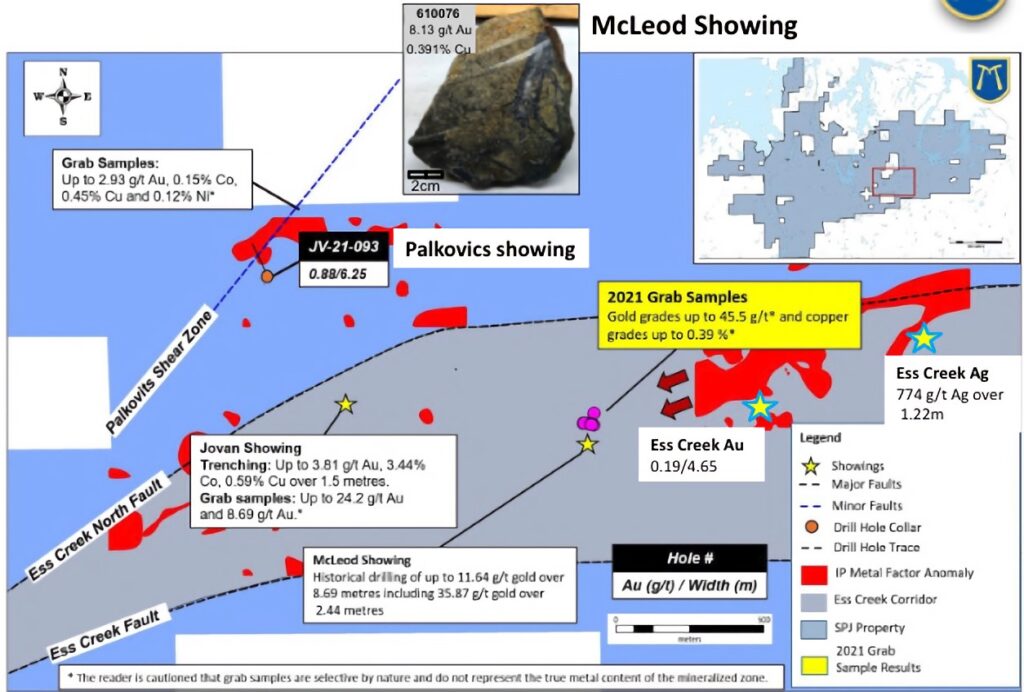
Palkovics Corridor:
- Potential for broad zones of polymetallic mineralization at Palkovics:
- 0.15 g/t Au, 0.005 g/t Ag, and 0.01% Co over 20.48 m, including 0.17 g/t Au (JV-21-090)
- 0.035% Co over 3.15 m & 0.87 g/t Au, 0.008 g/t Ag, 0.024% Co and 0.007% Cu over 6.25 m, including 1.20 g/t Au, 0.01 g/t Ag, 0.024 % Co and 0.007% Cu over 4.25 m (JV-21-093)
- Au and Co mineralization overprinting Na alteration
- Mineralization associated with Cb alteration and Py mineralization
- As-Py associated with Au
- Co-Py associated with Co
- Trends to the Crerar Au-Co-Cu showing where grab sample contained up to 8.87 g/t Au and 2.96% Cu
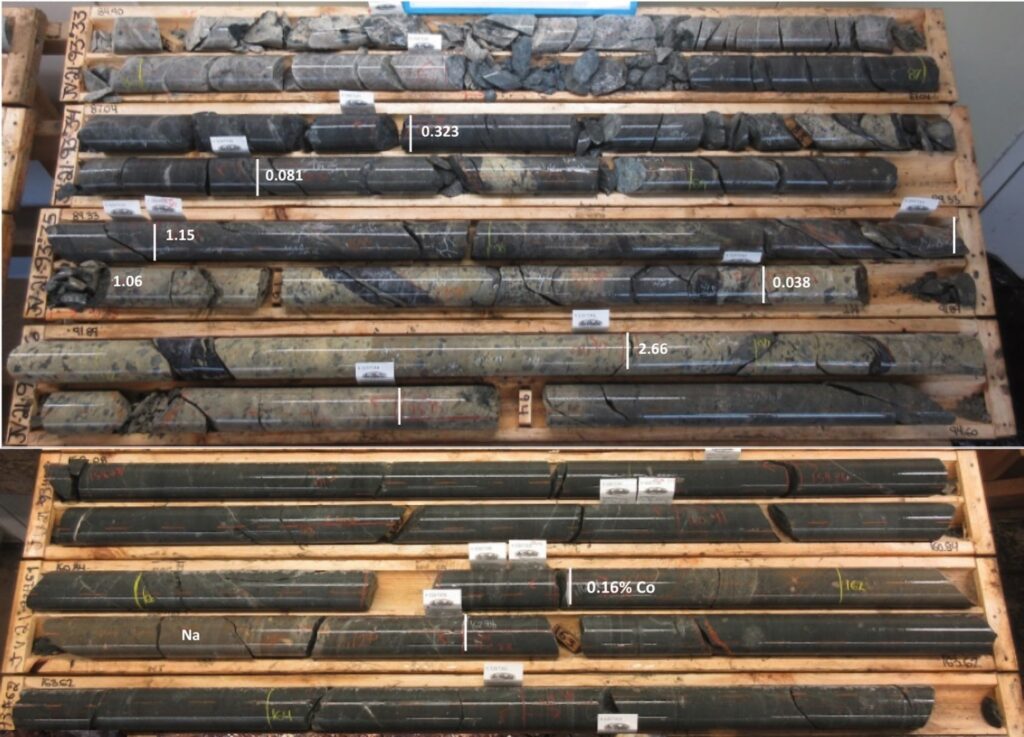

Ess Creek Corridor:
- McLeod Au-Cu Showing
- Au grades between 0.01 and 45.5 g/t and Cu grades between 0.023% and 0.39% in grab samples collected during the 2021 field season
- Au-Cu mineralization in semi-massive, fracture filling arsenopyrite-chalcopyrite-pyrite within albitized felsic intrusive unit and sediments
- Primarily fracture/joint controlled with possible mineralized lenses concentrated in shallowly plunging fold hinges
- Jovan Au-Co-Cu Showing
- 6.85% Co, 7.36 g/t Au, 1.05% Cu over 0.75 m and 14.74 g/t Au, 4.70% Cu over 0.8 m in 2002 channel samples

Ess Creek Ag and Au Mineralization
- Anomalous Au mineralization observed in associated with Apy disseminations in albitized tonalite
- 0.5 g/t Au over 1.26m (JV-21-086)
- 0.19 g/t Au over 4.65m (JV-21-087)
- Au mineralization observed in the Ess Creek Deformation Zone
- 0.85 g/t Au over 1.31m (JV-21-084)
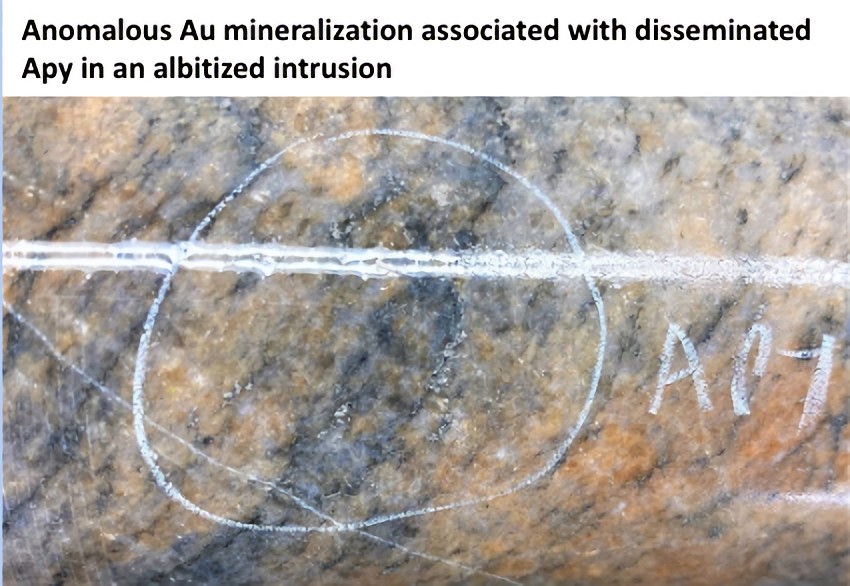
- Ess Creek Ni-(PGEs) Mineralization
- Amp-(Ap)-Po-Py alteration and mineralization associated with Ni-(PGE-Cu) mineralization
- Exploration drilling demonstrated the association between Ni-Cu-PGE mineralization and the geophysical anomalies (low resistivity, high metal factor)


